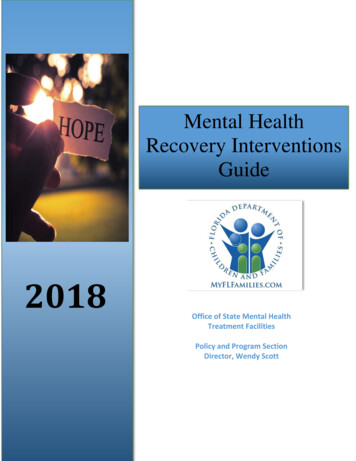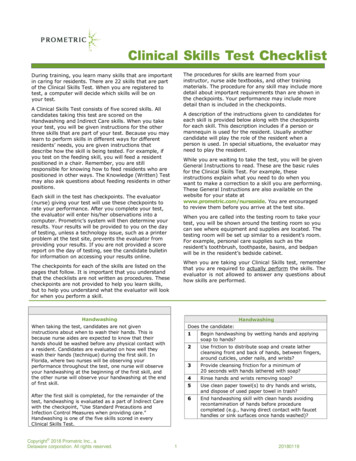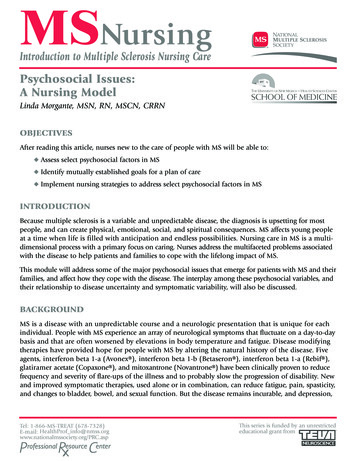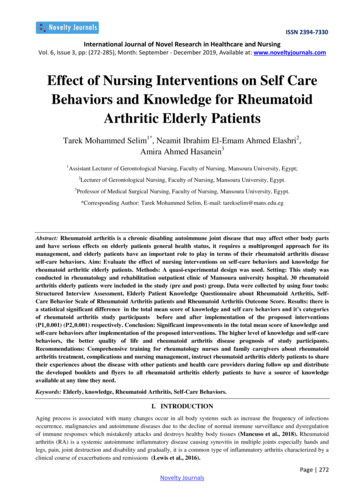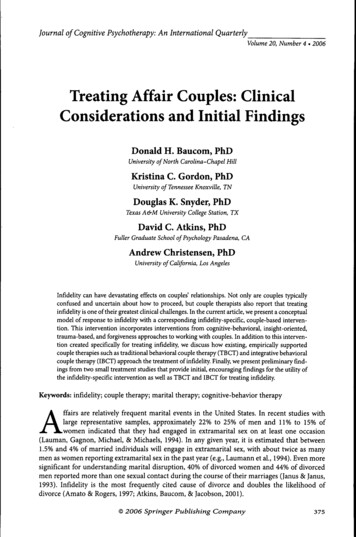
Transcription
This book takes an integrated approach to therapeutic counseling, from personality theory, toapplying that theory in assessing client problems, to the techniques to intervene. The counselingprocedures presented allow the counselor to determine the origin of unwanted emotionsand behaviors without psychodynamic interpretation and the interventions are designed toaddress the cause for these concerns.There is a cause for every unwanted emotion or reaction. This book is about understandingthese causes and facilitating change.Gordon Emmerson, PhD is a senior lecturer in psychology at Victoria University in Melbourne and is assistanteditor of the Australian Journal of Clinical Hypnosis and Hypnotherapy. He has been Victoria State President of theAustralian Society of Clinical Hypnotherapy and has conducted and published clinical research papers on ego-statetherapy and its efficacy.“This is a significant contribution to the entirefield of psychotherapy.”“ the most refreshing text of its kind to appear inmany years. clear, concise, and stimulating.”John G. Watkins, PhD, Past President, The InternationalSociety For Clinical and Experimental HypnosisProfessor Arreed Franz Barabasz, EdD, PhD, ABPP,Editor, International Journal of Clinicaland Experimental HypnosisLyn Macintosh, Counsellor,Hypnotherapist, NLP Master Practitioner“Definitely a valuable contribution and an asset tothe bookshelf!”Stefanie Badenhorst, DLitt,Director, Milton H. Erickson Institute“As a practising clinician I was thrilled to read thisbook. It is refreshing to find a guide for therapythat starts at the very foundations of any therapy– with ethical guidelines, and listening skills”“The author’s combination of wisdom, intelligenceand compassion make it a ‘must read’ forany caring counselor around the world. In myopinion, history should record Gordon Emmersonas a master of ego-state therapy.”Barb Wood, Psychologist,Family Therapist, HypnotherapistC. Roy Hunter, MS, FAPHP, Author of Hypnosis for InnerConflict Resolution: Introducing Parts TherapyISBN 184590017-090000Advanced Skillsand Interventionsin TherapeuticCounselingTherapeutic Counseling and EthicsTheoretical OrientationBasic Counseling SkillsGordon Emmerson, PhD“ nothing short of brilliant. I’ve used ego-statetherapy with clients for a number of years and Ifeel sure that this valuable book will influencemany to also use this most effective technique.”Advanced Skills and Interventionsin Therapeutic CounselingAdvanced Skills and Interventions in Therapeutic Counseling is written for advanced studentsand professionals. It provides an understanding of the personality and reviews the fundamentalsof the counseling process, such as the set up of the counseling room, attending behavior, andadvanced active listening skills. It also provides a means to assess clients so the direction oftherapy is clear and details case examples for each direction of the therapeutic process.Advanced Counseling SkillsAssessing the Client’s ProblemTherapeutic Interventions for:DepressionAddictive PersonalitySexual AbuseRelationship IssuesObsessive Compulsive BehaviorTrauma and CrisisGrief and LossSuicidal IdeationCrown House Publishing Limitedwww.crownhouse.co.ukCover design Thomas Fitton9 7 81 845 9001 7 5Gordon Emmerson, PhD
Advanced Skillsand Interventionsin TherapeuticCounselingGordon Emmerson, PhDCrown House Publishing Limitedwww.crownhouse.co.uk
First published byCrown House Publishing LtdCrown Buildings, Bancyfelin, Carmarthen, Wales, SA33 5ND, UKwww.crownhouse.co.ukandCrown House Publishing Company LLC4 Berkeley Street, 1st Floor, Norwalk, CT 06850, USAwww.CHPUS.com Gordon Emmerson 2006The right of Gordon Emmerson to be identified as the authorof this work has been asserted by him in accordance withthe Copyright, Designs and Patents Act 1988.All rights reserved. Except as permitted under currentlegislation no part of this work may be photocopied, stored in a retrievalsystem, published, performed in public, adapted, broadcast, transmitted, recorded orreproduced in any form or by any means,without the prior permission of the copyright owners.Enquiries should be addressed toCrown House Publishing Limited.British Library Cataloguing-in-Publication DataA catalogue entry for this book is availablefrom the British Library.10 digit ISBN 184590017013 digit ISBN 978-184590017-5LCCN 2005931938Printed and bound in the UK byBell & Bain LtdGlasgow
ContentsPrologueExamples of Therapeutic TechniquesChapter 1: Therapeutic Counseling and EthicsWhat is therapeutic counseling?Ethical issuesThe ethical personConfidentialityMaintaining boundaries in therapyDual relationshipsDuty of careivii11233589Chapter 2: Theoretical Orientation11Ego states12Development of ego-state therapy13Ego-state personality theory16The origin of ego states16The executive state18Surface and underlying states19Ego states and alters19The unconscious20Introjects20Later development of ego states21Pathology and ego states22Malevolent ego states23Ego states and physiology24Overview of ego-state personality theory25Ego-state theory and techniques in the context of other psychotherapies 26The psychodynamic stream26The cognitive behavioral stream28The phenomenological stream29Role of ego-state theory in counseling32iii
Advanced Skills and Interventions in Therapeutic CounselingChapter 3: Basic Counseling Skills and TechniquesAttendingAttirePreparation of the roomBody language and voice toneInterest shown to the clientMaintaining focus in the client’s worldActive listeningBenefits of active listeningGood active listeningStarting and ending a sessionBeginning the sessionBringing the session to closeThe last session3333333434353637373944454646Chapter 4: Advanced Counseling Skills and TechniquesAccessing ego statesNaming ego statesSpeak respectfully to all statesWhen working with ego statesAccessing ego states—a reviewWorking with introjectsSpeaking to an introjectSpeaking as an introjectHow the counselor can facilitate conversations with introjectsSpeaking to the introject of a deceased personSpeaking to the introject of a fetusSpeaking to the introject of a perpetratorBridging from the unwanted symptom to the cause of the problemResolving a trauma494951535555565758596162626567Chapter 5: Assessing the Client’s ProblemDSM-IV-TR diagnosisThe counseling assessment method696970Chapter 6: Internal Dissent: Cognitive DissonanceHelping the client resolve internal dissent1. Get a clear understanding of the division and of the states involved2. Make clear which state will sit in each chair3. Listen to everything each state has to say7576818181iv
Contents4. Help each state to see the value of both states5. Suggest how nice it would be to have the respect of the other state6. Negotiate a way the states can work together7. Suggest that the states communicate directly with each other8. Thank each state for working together to achieve a solution9. Debrief with the client818282828383Chapter 7: Difficulty Responding to a Situational ConcernCurrent-context-situational concernUnresolved-issues-situational concern: trauma resolutionAbreactions858799115Chapter 8: Applications of SkillsCrisis interventionWhat are the elements of the effective crisis intervention?When the crisis trauma does not involve another personWorking with grief and lossGrieving lossGrieving future lossDealing with angerThe problem with anger that is not expressedThe problem with anger that is expressed inappropriatelyAssertive behaviorUnderstanding angerAnger therapy techniquesRelationship issuesDealing with depressionAntidepressant medicationSteps in working with the depressed clientWorking with addictions and obsessive-compulsive disorderGamblingDrug addictionObsessive-compulsive disorderSelf-harming behaviorSmokingCompulsive eatingWhat addictions have in commonTechniques for working with clients with addictive behaviorNonaddictive eating and smoking 162163163170170171171172172173173174184v
Advanced Skills and Interventions in Therapeutic CounselingDealing with sexual-abuse issuesDo not minimize or maximize the problemTechniques for working with the sexually abused clientDealing with suicidal ideationUnderstanding the suicidal clientTechniques to assist the client through the critical period ofsuicidal ideationTechniques to assist the client with the issues that broughton the suicidal ideationWhat if one of your clients commits suicide?192193194197197199Chapter 9: More Training for Difficult CircumstancesExamples of dialogue with ego statesWhen the client has difficulty naming an ego stateWhen the client has difficulty finding an ego state that canhelp another stateAccessing the desired stateWhen the client is reluctant to speak to an empty chairWhen the client does not speak directly to the introject inthe empty chairAn important issueSpontaneous hypnosisFinal vi202204210211212213
Examples of Therapeutic TechniquesActive listeningEmotive active listeningInterpreted responseUsing statements of confusionSpeaking respectfully to ego statesResolving internal dissentRelationship problemLocating inner resourcesTalking with an introjectDebriefing with a clientResolving a traumaBridging to the origin of the problemFacilitating expression during a traumaFacilitating removal of fearFacilitating a feeling of relief after a traumaUsing imagery to test success of an interventionCrisis interventionLoss and griefDealing with angerWorking with depressionAddictions (gambling)Eating and smoking (when not an addiction)Responses to a suicidal client38394243537689919496103106108109109113121, 127138153164175186200Examples of working with some specificproblemsProcrastinationCommunicating with a teenage sonResponding to an authority figureRemembering a sniperRemembering an earthquakeTroubled after an abortionKilled dog in a rage7689103122127138153vii
Advanced Skills and Interventions in Therapeutic CounselingDepressed due to burn injuriesCan’t avoid poker machinesWants to stop smokingviii164175186
Chapter 1Therapeutic Counseling and EthicsWhat is therapeutic counseling?Professional therapeutic counseling is the process whereby a trained individual assists another individual, or group, in some type of personal problemresolution or desired personal growth. But is that all therapeutic counselingis? I think not, and I hope not. In order for change to occur there needs tobe a particular interaction between the counselor and the client, based atleast partly on the will and intent of each. If the client does not want to participate in counseling, effective counseling cannot occur. Likewise, if thecounselor does not have the will to help, counseling will be of diminishedvalue.The desire to be a counselor is not one shared by all individuals. Duringtraining, I have heard various accounts of the reasons students decide tobecome counselors. One common account is, “It seems like I am alwayshelping people with their problems, so I thought I might as well make it aprofession.” I have found, almost without exception, that students in counseling see the profession as more than a way to earn income: they see it as away they can help others. There is something about helping others thatappears to fulfill some of their own needs. This desire to help appears synergistic, since studies have shown that clients who believe their counselors careabout their improvement make the best progress (McCabe and Priebe,2004).Therefore, counseling seems to be more than a mere exchange of conversation and professional techniques. Speaking in terms of individual counseling, two people come together, one with a desire for change and the otherwith a desire to help facilitate that change. At least in part, the interactioncreated by this common desire seems to be important in the outcome, theamount the client is able to make desired change (McCabe and Priebe,2004).1
Advanced Skills and Interventions in Therapeutic CounselingOne of the hardest clients to have, and one of the hardest to help change,is the client whom someone else has talked into coming to counseling.Unless the client wants to be there, is ready for change, and is ready toengage with the counselor, it is difficult for any counselor to be of assistance.So, for the most effective counseling to occur, there needs to be the coming together of two people with a common goal, one to change and one tohelp in that change. The client has taken a sometimes large step in comingin to see the counselor. The motivation for change has become greater thanthe reticence to come in, the expense and the time. Often, the client willarrive in a vulnerable state, unable to understand or see a way forward. Theclient may fear sharing what is inside, while hoping to have the courage to dowhat is necessary to feel better or grow.The counselor is a person who has chosen the helping profession becauseit helps to fulfill something that is needed. The counselor has the opportunity to be invited into the inner world of the client. It is an honor to betrusted enough for inner fears to be shared. Almost to a person, the counselor earnestly wants to take on the mandate of helper and be of real assistance to the client.Counseling, while focused on the issues of the client, is a working togetherof two people for the benefit of both. The will of both has importance to thefinal outcome. Still, beyond wanting to help, it is important to have powerful and effective tools to facilitate change. It is hoped that the tools offeredin this book will assist counselors in a real way toward achieving the positiveoutcomes they want for their clients.Ethical issuesAdhering to appropriate ethical principles is the responsibility of every counselor. The counselor is a person who is given information and insights intothe inner life of the client. The client is often vulnerable and trusting, andrightfully looks to the counselor for direction on ethical issues as they pertainto the counseling setting. Determining the appropriate ethical course ofcounseling is not easy, and cannot ever be fully delineated in any text. Often,context must be considered in the choice of the most ethical course of action.While this section on ethics is not intended to be a thorough overview ofethical principles, it would be remiss not to highlight some of the mostimportant ethical considerations. These considerations are divided into five2
Therapeutic Counseling and Ethicscategories below, the ethical person, confidentiality, maintaining boundariesin therapy, dual relationships, and duty of care.The ethical personEthical guidelines must be interpreted and applied to real situations and realpeople. It is my belief that before a counselor can truly be ethical, he or shemust do more than merely attempt to logistically apply guidelines to counseling situations. Contextual interpretation is often necessary, and only anethical person can make interpretive judgments in an ethical manner. Theethical or honorable person will be able to seek and choose what is internallydeemed “right” over “personal gain”. Personal curiosity, need for power,desire for money, need for relationship, or any other self-serving need shouldbe relinquished in favor of “doing the right thing”. The ethical person has aninner sense of honor and peace and a positive knowledge that “Who I am” ismore important than “What I want”.The ethical person will be able to honorthe client and make appropriate distinctions in difficult decisions. It is alsoimportant to understand ethical guidelines and to be able to discuss withanother appropriate professional ethical dilemmas.ConfidentialityOne of the most important aspects of ethics and counseling is confidentiality. Clients often share with their counselors information and aspects ofthemselves that they either rarely share, or have never shared, with anotherperson. It can be very frightening to open oneself, however fragile, trust, andtell it like it is. It is tragic if clients, after trusting, hear their story from someone else. It is often this fear that prevents clients from sharing their innermost feelings. It is appropriate to explain to a new client what confidentialitymeans in therapy, and to assure the client that there exists the utmost respectfor maintaining that high-level confidentiality.Breaching confidentialityIt is good to outline to the client when confidentiality might ever bebreached, and when it would never be breached. Generally, it is the responsibility of the counselor to breach confidentiality if clients, in the professionalopinion of the counselor, are at real threat of hurting themselves or someoneelse. For example, if the client is determined to commit suicide, and it is theprofessional opinion of the counselor that this danger continues to exist, it is3
Chapter 4Advanced Counseling Skillsand TechniquesThe chapter on basic counseling skills covered aspects of listening andattending. This one provides instruction in how to speak with individual egostates and introjects, and it begins by providing instruction relating to thetherapeutic value of these techniques. Being able to gain direct access withthe part of the client that has the problem is a powerful tool in counseling.While what ego states are, where they come from, and their lasting naturehas been discussed earlier, in order to best understand the techniques forcommunicating with ego states it is useful to review an aspect of the natureof ego states. Each ego state is a part of the personality, and, while executive(conscious and out), each state thinks of itself with ego identity, that is, itthinks it is the person. Therefore, talking to a single ego state is like talkingto an individual. It is important to speak respectfully to each and every egostate that is spoken with. If any ego state believes, or feels, that you, the counselor, do not like or respect it, it will not work with you in a positive way, andit may even hide or not speak with you. Speaking respectfully to all states willbe discussed further, while the first instruction will be provided in terms ofhow to access and speak with each state individually.Accessing ego statesIt is not difficult to access individual ego states and speak with them separately. It is important to learn to recognize ego-state switching so individualstates can have a better opportunity to express themselves more fully. Forexample, if a client says that there is a part that would really like to quitsmoking and another part really enjoys smoking, two parts are evident. Thecounselor can be aware of which of the two parts is speaking by watching thecontent of the words and the expression of the client while the client is talking. Statements such as “I know I really have to quit: my health’s sufferingand it’s stupid, the amount of money that I’m spending on smoking” obviously indicate that the state that wants to quit has the executive. If the client49
Advanced Skills and Interventions in Therapeutic Counselingthen says, “But, I really enjoy a cigarette, and when I’m with my friends whosmoke it’s really hard for me to turn down an opportunity to smoke withthem; a cigarette is also really good after a meal,” the counselor can see thatthe client has switched to the state that enjoys smoking.A good way to begin talking with ego states individually is to use multiplechairs. For example, the counselor might say to the above client, “Whileyou’re in this chair I want to hear only from that part of you that wants toquit smoking. When you change to the other chair, I will have an opportunity to hear how you like to smoke, but in this chair I want to hear only froma part of you that really wants to quit.” If, while speaking from the quit chairthe client begins telling a reason why smoking is good, the counselor shouldstop the client and say, “Remember, in this chair I only want to hear how youwant to quit, and you’ll be able to tell me the good things about smokingwhen you sit in the other chair.In working with ego states, it is very important for the counselor to continue to monitor the client so that each ego state can be heard individually.This way, each ego state will be able to be heard, and will be able to have itsneeds met. As the counselor gains more proficiency in noticing ego-stateswitching, a number of chairs may be used so that all ego states involved inthe presenting concern of the client can be heard.Continuing with our example, the counselor should talk with the ego statethat wants to quit smoking until it has had a good opportunity to express allthe reasons quitting is good. Then, the counselor can say something like,“OK, now I want you to sit in this chair [pointing to the other chair] and asyou sit in this chair, I only want to hear the good things about smoking. Iwant to hear only from the part of you that smokes.” Conversation with thesmoking state should continue until this ego state has a full opportunity toexpress itself. Every state needs to be able to express itself fully for the bestoutcome to occur.It may be the case that more than one ego state will share the same opinion. For example, when the client is talking about reasons to quit smoking,the counselor may notice that, while the reasons are about health and fear ofdying (emotive), the client has a different affect than when the reasons areabout saving money (intellectual). It is best, when this is the case, to set outanother chair so both the emotional health-conscious state and the intellectual money-conscious state may be fully expressed. This is especially important when determining whether each state is satisfied with the conclusion. Ifmultiple states are talking from the same chair, one state may express satisfaction while another would not.50
Advanced Counseling Skills and TechniquesNaming ego statesIt is helpful and important to get a name for each ego state while workingwith it. It is best if the state can name itself. In order for this to happen, thequestion, “What can I call this part of you?” is best asked after talking witha state for a few sentences in order to make sure that the ego state to benamed is currently executive. It would not be appropriate to ask the statethat wants to quit smoking for a name for the state that wants to continuesmoking. A name might be given that the smoking state would be dissatisfiedwith, and it is important for all states to feel respected during therapy.States sometimes have difficulty giving themselves a name.When this happens it is okay to suggest a possible name, such as “Health”, but it is alwaysappropriate to check with the state to see if the suggested name is acceptable.For example, “This part of you I’m talking with right now seems concernedabout your health. Is it OK if I call this part of you, Health?” It is interestingthat sometimes when a state is asked, “What can I call this part of you?”, apersonal name is given such as Jane, Sue, or Mary—a name that may havenothing to do with the name of the client. If this occurs, the personal namethat is given can be used to refer to the state.It is important to keep good notes so that you will be able to rememberwhich names go with which ego states. If you are working with a number ofego states using a number of chairs it can be helpful to write the name ofeach state on a piece of paper and place it on the chair. This way, both thecounselor and the client can keep track of all states in the conversation.Good note taking is imperative when doing work with ego states. It can behelpful to circle the name of each state on the page and write the attributesof that state next to the circled name. This way, when the counselor wants totalk to the state that is concerned about health, the client can be asked to sitin that state’s chair and, as he or she sits down, the counselor can say something like, “Now I want to talk just with Health, the part of you that is reallyquite upset about what cigarettes are doing to your body, that part thatwould like to breathe more deeply and live longer. Health, what do you thinkabout ?”It is somewhat surprising and interesting how quickly clients are able tospeak directly from their ego-state parts. It is common for clients to expresssurprise about this at the end of the session. When clients change ego states,as they change chairs, their affect often changes dramatically. It may be thatwhile a client is in one ego state, he or she will appear fragile and teary, andwhile expressing from another ego state the same client will appear aloof,51
Chapter 8Applications of SkillsThis chapter discusses and illustrates ego-state counseling techniques for anumber of presenting concerns. These presenting concerns are by no meansillustrative of the full range of problems clients bring to counseling. It ishoped that the reader will gain conceptual understandings by studying thischapter so that techniques may be more broadly applied. The reader shouldremember that counseling is ethical only when the counselor is trained andfeels competent in offering services for the concerns presented. A number oftherapeutic examples are provided in an attempt to help clarify techniquesfor dealing with particular concerns.Crisis interventionEffective crisis intervention is important in order for the client to keep fromhaving residual issues connected with the immediate trauma. Following atraumatic incident, when the effective crisis intervention does not occur, theclient is left with an ego state holding fear and misunderstanding. This egostate will hang onto the fear and misunderstanding, thus creating a tenderspot in the psyche of the person. Later, when a situational event subconsciously reminds the person of what is unresolved, this tender ego state willre-experience the fear and misunderstanding associated with the originaltrauma. Therefore, it is very important for each individual to be able toexpress, feel understood, and gain perspective after a traumatic event so thatthe negative feelings event will not continue to re-emerge in the future.Often, effective crisis intervention occurs through the actions of a friendor family member. It is most important that a person who has experienced atraumatic event should be able to talk about that event to a respected personwho can be understanding. It is also important for the person who has experienced a traumatic event to be able to gain a level of understanding aboutthat event, so that person can feel secure that either another event of thattype will not happen in the future, or there is a clear understanding of thepotential for another event of that type to occur. Because it is normal forindividuals who have experienced a traumatic event to talk about their119
Advanced Skills and Interventions in Therapeutic Counselingexperience, effective crisis intervention most often occurs through these conversations with family or friends.Sometimes, for various reasons, individuals do not talk about the traumathey have experienced, or they do not talk about it enough to feel expressedand to gain perspective. Even adults may choose to hold the negative feelingsinside themselves, and may be reluctant to revisit what gave rise to them, butchildren are the most likely persons to hold traumatic events inside. Theymay not have anyone they feel safe to talk with. They may also be instructednot to tell, by either another child or an adult. They may fear telling. Beloware some examples of crisis events that may not be discussed, either by adultsor children. A man who works in the convenience store is robbed at gunpoint. Later,he says, “It’s no big deal. I would prefer not talk about it.” A child is afraid in a room, and calls repeatedly for a parent to come. Asthe parent either does not hear or chooses not to come, the child becomesmore and more afraid. Later, the child never tells anyone about the fear. A child or adult is the victim of sexual abuse or rape. Because of fear orembarrassment no one is told. A child almost drowns while swimming in a place that was forbidden. Noone is told. A woman is stranded behind the car when a sniper is firing at the crowd.Afterward, it seems too difficult for her to talk about, so it is not processed.Obviously, these represent only a small sampling of crises that should beaddressed near the time of the event. When the crisis is addressed near thetime of the event the work of the counselor is somewhat more simple thanresolving the issue years later because no bridging is needed. An examplemay be beneficial.A transcript of a client in Ego State Therapy (Emmerson, 2003) details theexperience of a client who suffered from panic attacks for many years. Shehad difficulty getting on a crowded elevator when she would have to standtouching another person; she had difficulty in dark places, especially whenother people were there; and she had difficulty at times when she felt the airwas bad or that she might not be able to get enough air. She had no idea whypanic attacks would occur at these times. During the attacks, she felt like ripping something away from her neck, and she said she just felt as if she hadto get away. These panic attacks were caused by a traumatic event that hadnot been resolved, had not been talked about and understood.120
Applications of SkillsBy bringing out the negative feelings and bridging to the event that relatedto them, it was found that when she was ten years old she almost drowned.She was caught in an ocean riptide that kept her from being able to swimback to land. Her little cousin was hanging onto her around the neck, making it even more difficult for her to breathe and to keep her head above thewater. Her face would go down into the dark “blue-black” of the oceanwater. She experienced real fear of dying. After making it to land, she wasafraid that she would be in trouble with her parents if they found out she hadbeen swimming at that location. She never to
in Therapeutic Counseling Gordon Emmerson, PhD Advanced Skills and Interventions in Therapeutic Counseling is written for advanced students and professionals. It provides an understanding of the personality and reviews the fundamentals of the counseling process, such as the set up of the

